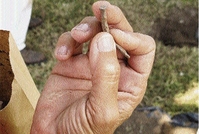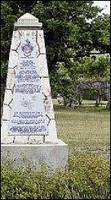
Archaeologist Ivor Connelly holds a handmade nail found at the Papine slave village site. - Photo by Michael Robinson
Ceramics have a story to tell at the University of the West Indies (UWI), Mona campus, and the narrative is slowly being crafted by archaeologists who are unearthing evidence of an 18th century slave village there.
Situated beside a section of the Mona aqueduct beside Taylor Hall, the Papine village is providing information about the cultural practices and lifestyles of these Jamaicans who have, so far, had no written history.
The dig is being run under the auspices of the Digital Archaeological Archive of Comparative Slavery (DAACS), a web-based initiative designed to promote comparative archaeological research on slave-based societies in the United States and in the Caribbean. DAACS, funded by the Thomas Jefferson Foundation, has a 3-year licence from the National Heritage Trust, and this is their second year at the Papine site.
Local team

An obelisk built as memorial lists the names of slaves on record who might have lived at the Papine slave village at the time of emancipation. In the background is the Mona aqueduct and the Papine village site.
A local team, led by Ivor Connelly, consisting of faculty and students from UWI's Department of History and Archaeology, as well as volunteers, has been working in tandem with the DAACS team. Although it's still "early days," Dr Suzanne Francis Brown, a heritage consultant associated with the project, is excited about the findings.
The new information, she says, "dovetails" with available historical records and old maps. The consultant and author will be playing a key role in the creation of a slave dwelling replica slated for construction.
Artefacts are found by digging test pits, small holes about two feet in diameter where a student or volunteer uses a spade to dig straight down, sifting the soil removed to check for items of note. The idea, says Dr Francis Brown, is to look for anything that indicates human intervention in the landscape. If the test pits turn up evidence that indicates further exploration is necessary, then an excavation pit is created. Excavations are done in one-metre squares at a time and involve a careful stripping away of earth, layer by layer, so as not to damage any artefacts found.
Findings posted on the web
All items found are sent away to Monticello's labs in Virginia for analysis and cataloguing, and then sent back to the National Heritage Trust in Jamaica. The information is available on the organisation's website, DAACS.org.
Ceramics, fragments of hand-made mirrors and wine bottles, tobacco pipe stems, mortar and burnt limestone have been found. According to Fraser Neiman, Monticello's director of archaeology, work at the Papine village site shows two broad classes of locally made ceramics in the 18th and 19th centuries. One was produced for household use by individuals, the other type is specialist-produced, most likely made by enslaved people, but made for a market. These ceramic items were being produced for sale, which indicates that these slaves had much greater levels of participation in the local economy than previously thought.
More specialised economy
The latter type of ceramics, found mainly in the Kingston and St Andrew area, says Neiman, shows that the Jamaican economy was becoming more specialised at the beginning of the 19th century, and some floundering sugar estates might have been turning to other ways of making money. This contrasts with the group's findings in other countries like Nevis, where only home-made ceramics are found right up until, and even after, emancipation.
The UWI's Mona campus has a rich history. The university sits on two old sugar plantations, Papine Estate to the north and Mona Estate to the south. The old Dramatic Theatre and the old library are remnants of Gibraltar, a World War II evacuee and refugee camp. An obelisk erected at the Papine village site is one of four across the UWI grounds that represent the enslaved population, according to listed records, who likely inhabited the area at the time.